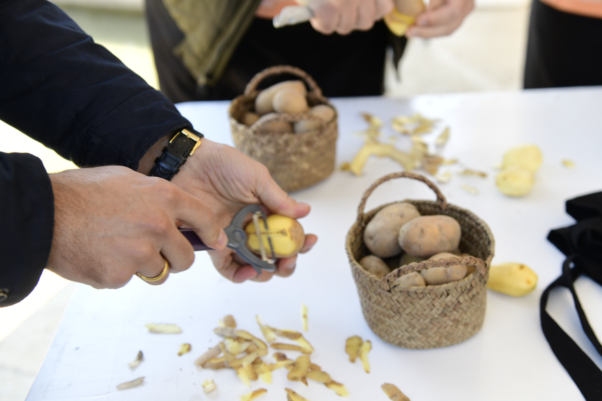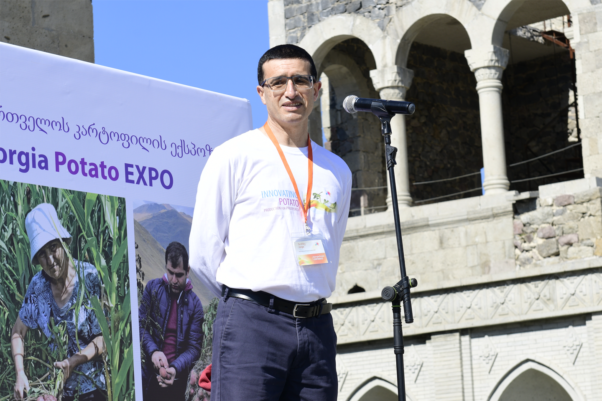 Potato is an important staple and cash crop in Georgia with great potential for improving nutrition, food security and incomes throughout the country. But current potato production (12 tons per hectare) in the country are far below potential yields of as much as 30 tons per hectare.
Potato is an important staple and cash crop in Georgia with great potential for improving nutrition, food security and incomes throughout the country. But current potato production (12 tons per hectare) in the country are far below potential yields of as much as 30 tons per hectare.
For this reason, USAID has linked hands with the International Potato Center (CIP) and the Government of Georgia to support a five-year initiative aimed at boosting the potato sector by improving availability of quality seed potatoes and potato varieties and fostering stronger links between farmers and the marketplace.
CIP and USAID hosted a two-day conference and expo in Tbilisi last month to celebrate the initial achievement of this venture while looking forward to anticipate future challenges to potato production.
On the opening day, Barbara Wells, the Director General for CIP and recently-appointed Global Director for Genetic Innovations in One CGIAR, delivered opening remarks (via proxy) and pointed to the institutions past success working in Asia as reason for hope.
“One CIP variety, called Cooperation 88, netted nearly 3 billion US dollars in additional income for farmers in China over a ten-year period. Finding the right varieties for Georgia, while building stronger links along the value chain will help us achieve many good things for potato production,” she said.
Expanding the potato sector could bring impressive economic gains to Georgia through export, according to Solomon Pavliashvili, the Deputy Minister of Environmental Protection and Agriculture in Georgia.
“Last year, we exported 30,000 tons of early potatoes [for sale]. By increasing farmer yields, we can expect to export more to other regions of Europe,” he told the audience. “The new disease-resistant varieties from CIP will help our farmers and the whole potato sector reach that goal.”

While boosting production is one key objective, the full value chain must be strengthened to ensure that transport and markets are available for more potato.
“[USAID and CIP] are focusing on the root causes of the obstacles to building the potato sector by introducing technologies to address these challenges and by working with the private sector to create pathways to link rural farmers with urban buyers,” said Marika Olson, the USAID Office Director for Economic Growth in the Caucasus region.
A key aspect of the Georgia Potato Program will be a Potato Producers Network (PPN) that will operate as a forum for sharing knowledge on markets and agricultural practices.
“The network will help protect and defend farmers’ interests in potato production, which will incentivize more farmers to invest in the technologies and new varieties that are made available through this program. In the end, we expect all the farmers to emerge stronger and better positioned for achieving success,” said David Tsiklauri, a Senior Private Sector Development Advisor with USAID.
One best practice that will shared through the PPN is improved cultivation of plantlets to produce high-quality and disease-free seed potato. Nodar Khatiashvili, the Deputy Director of Georgia’s Agricultural Research Center, said CIP past work in the country gave him great confidence in producing not only better seed potato but also improved varieties that will be adapted to the growing conditions in Georgia.
“With CIP’s assistance, we expect that potato certification and standards will be in place by 2024 and these procedures will ensure that our farmers and consumers have access to better quality potato,” he said.
The comments from the speakers pointed to power of partnerships to leverage expertise and innovation – something noted by Pietro Turilli, CIP’s Director of Resource Mobilization, noted in his remarks.
“There is ample scope for more work in this region to boost potato production and agriculture in general. And partnerships help us take a more integrated approach so we can bring all of our science muscle to help in local contexts.”
Day 2 of the event (the first Georgia Potato Expo) featured four stations that highlighted CIP’s work around the world and in Georgia, focused on improving production technology (e.g., hydroponics and apical rooted cuttings) and market and organization innovations (e.g., producer networks).
Introductory remarks were given by Peter Wiebler, the USAID Mission Director to the Caucasus Region, George Khanishvili, the First Deputy Minister in the Georgia Ministry of Environmental Protection and Agriculture, and Besik Amiranashvili, the Governor of the Samtskhe-Javakgeti Region, where potato production is significant.
CIP Senior Scientist, Jorge Andrade Piedra, provided an overview of the technologies that are being used to improve potato production in Georgia and that may, in time, boost potato yields throughout Central Asia.

The event was capped off by a potato peeling competition between men and women from the Potato Producers Network and the Potato Council, The women won.
In her closing remarks, Rusudan Mdivani, CIP’s Regional Leader for Central Asia and the Caucasus, said the event marked just the beginning of a fruitful partnership to boost incomes and nutrition for Central Asian farmers.
